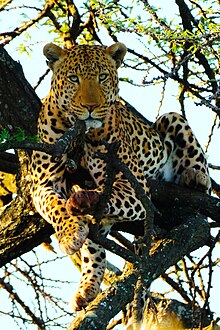
Back Luiperd Afrikaans ግሥላ Amharic Panthera pardus AN Lafor ANG نمر Arabic ܢܡܪܐ ARC فهد ARZ নাহৰফুটুকী বাঘ Assamese Panthera pardus AST Kraimol (Panthera pardus) AVK
| Leopard Temporal range: Late Pliocene or Early Pleistocene to recent
 | |
|---|---|
| Scientific classification | |
| Domain: | Eukaryota |
| Kingdom: | Animalia |
| Phylum: | Chordata |
| Class: | Mammalia |
| Order: | Carnivora |
| Suborder: | Feliformia |
| Family: | Felidae |
| Subfamily: | Pantherinae |
| Genus: | Panthera |
| Species: | P. pardus[1]
|
| Binomial name | |
| Panthera pardus[1] | |
| Subspecies | |
|
see text | |

| |
| Range of the leopard: former (red), uncertain (yellow), highly fragmented (light green), and present (dark green) | |
| Synonyms | |

A leopard (Panthera pardus) is a big cat of the genus Panthera. It lives in Africa and Asia. It has a well-camouflaged fur (marked with rosettes), opportunistic hunting behaviour, animals kills and diet impala, thomson's gazelle, warthogs, and take down with attacking baboons while want to kills in Kenya and Tanzania migration many wildebeests, zebras, and guineafowls, storks, small reptile monitor lizards, stealthiness, elusiveness, broad diet, and strength. It adapts to many habitats from rainforest to steppe, including dry and montane areas.
The leopard is a secretive big cat. Unlike lions, leopards are usually solitary and do not live in groups, though it is not uncommon for young leopards to seek out the company of other leopards. Some territorial males even establish relatively tolerant relationships with the females in their immediate vicinity.[3] Leopards live in habitats where there are some trees. They climb trees well, and do so regularly. They can carry prey up a tree and keep it safe from hyenas and lions. Trees are its main escape from attacks by lions or packs of dogs. It is an ambush predator, and operates best where it has some cover. Leopards come out to hunt in the afternoon or late at night.
The most similar cat in its lifestyle is the jaguar, which lives in Central and South America. Both leopards and jaguars that are melanistic are called black panthers.
- ↑ Wozencraft, W. C. (2005). "Order Carnivora". In Wilson, D. E.; Reeder, D. M (eds.). Mammal Species of the World (3rd ed.). Johns Hopkins University Press. p. 547. ISBN 978-0-8018-8221-0. OCLC 62265494.
- ↑ Stein, A.B.; Athreya, V.; Gerngross, P.; Balme, G.; Henschel, P.; Karanth, U.; Miquelle, D.; Rostro, S.; Kamler, J.F.; Laguardia, A. (2016). "Panthera pardus". IUCN Red List of Threatened Species. Version 2016-3. International Union for Conservation of Nature. Retrieved 27 August 2016.
- ↑ https://africageographic.com/stories/leopards-silent-secretive-and-full-of-surprises/
